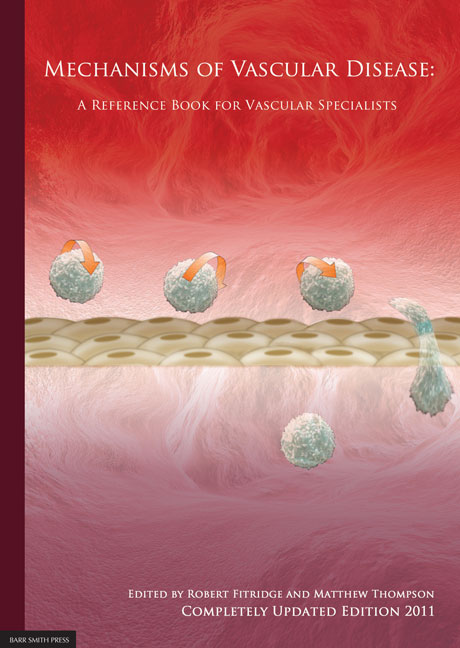Book contents
- Frontmatter
- Contents
- List of Contributors
- Detailed Contents
- Acknowledgements
- Abbreviation List
- 1 Endothelium
- 2 Vascular smooth muscle structure and function
- 3 Atherosclerosis
- 4 Mechanisms of plaque rupture
- 5 Current and emerging therapies in atheroprotection
- 6 Molecular approaches to revascularisation in peripheral vascular disease
- 7 Biology of restenosis and targets for intervention
- 8 Vascular arterial haemodynamics
- 9 Physiological Haemostasis
- 10 Hypercoagulable States
- 11 Platelets in the pathogenesis of vascular disease and their role as a therapeutic target
- 12 Pathogenesis of aortic aneurysms
- 13 Pharmacological treatment of aneurysms
- 14 Pathophysiology of Aortic dissection and connective tissue disorders
- 15 Biomarkers in vascular disease
- 16 Pathophysiology and principles of management of vasculitis and Raynaud's phenomenon
- 17 SIRS, sepsis and multiorgan failure
- 18 Pathophysiology of reperfusion injury
- 19 Compartment syndromes
- 20 Pathophysiology of pain
- 21 Post-amputation pain
- 22 Treatment of neuropathic pain
- 23 Principles of wound healing
- 24 Pathophysiology and principles of varicose veins
- 25 Chronic venous insufficiency and leg ulceration: Principles and vascular biology
- 26 Pathophysiology and principles of management of the diabetic foot
- 27 Lymphoedema – Principles, genetics and pathophysiology
- 28 Graft materials past and future
- 29 Pathophysiology of vascular graft infections
- Index
7 - Biology of restenosis and targets for intervention
Published online by Cambridge University Press: 05 June 2012
- Frontmatter
- Contents
- List of Contributors
- Detailed Contents
- Acknowledgements
- Abbreviation List
- 1 Endothelium
- 2 Vascular smooth muscle structure and function
- 3 Atherosclerosis
- 4 Mechanisms of plaque rupture
- 5 Current and emerging therapies in atheroprotection
- 6 Molecular approaches to revascularisation in peripheral vascular disease
- 7 Biology of restenosis and targets for intervention
- 8 Vascular arterial haemodynamics
- 9 Physiological Haemostasis
- 10 Hypercoagulable States
- 11 Platelets in the pathogenesis of vascular disease and their role as a therapeutic target
- 12 Pathogenesis of aortic aneurysms
- 13 Pharmacological treatment of aneurysms
- 14 Pathophysiology of Aortic dissection and connective tissue disorders
- 15 Biomarkers in vascular disease
- 16 Pathophysiology and principles of management of vasculitis and Raynaud's phenomenon
- 17 SIRS, sepsis and multiorgan failure
- 18 Pathophysiology of reperfusion injury
- 19 Compartment syndromes
- 20 Pathophysiology of pain
- 21 Post-amputation pain
- 22 Treatment of neuropathic pain
- 23 Principles of wound healing
- 24 Pathophysiology and principles of varicose veins
- 25 Chronic venous insufficiency and leg ulceration: Principles and vascular biology
- 26 Pathophysiology and principles of management of the diabetic foot
- 27 Lymphoedema – Principles, genetics and pathophysiology
- 28 Graft materials past and future
- 29 Pathophysiology of vascular graft infections
- Index
Summary
INTRODUCTION
Restenosis is usually defined as a re-narrowing of the arterial lumen occurring after a vascular intervention intended to treat ischemic lesions. This loss of lumen area results from the injury caused by all forms of vascular intervention, including direct repair (patch angioplasty, endarterectomy) and intraluminal approaches (balloon angioplasty, atherectomy, stent angioplasty). While there are clear differences between arteries and veins (review in), this review will also include discussion of stenosis after vein bypass grafting or creation of arteriovenous fistula dialysis access because stenosis in these cases also results from injury.
Lumen enlargement after angioplasty or stenting is the result of a combination of plaque reduction (compression and embolization), plaque redistribution within or outside the lesion area, and vessel expansion (see review). Failure occurs at early times because of technical problems and thrombosis (e.g. small diameter vein graft, limited out-flow, or hypercoagulability) and later times (1-18 months) primarily because of injury-induced scarring. At much later times (> 18 months), failure primarily results from the ongoing atherosclerotic process. Although restenosis occurs within the con- text of atherosclerosis, the clinical features and genetic control of atherosclerosis and restenosis are different. Atherosclerosis develops slowly over decades, while restenosis occurs within months to years.
The costs of restenosis are considerable, since greater than 20% of all interventions fail because of restenosis. In the U.S. alone, it is estimated that as many as 200,000 cases of drug eluting stent (DES) restenosis occur every year (see review).
- Type
- Chapter
- Information
- Mechanisms of Vascular DiseaseA Reference Book for Vascular Specialists, pp. 115 - 152Publisher: The University of Adelaide PressPrint publication year: 2011
- 6
- Cited by



